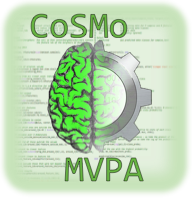demo fmri searchlight rsm¶
- demo_up:
demo_fmri_searchlight_rsm
%% Demo: fMRI searchlights with representational similarity analysis
%
% The data used here is available from http://cosmomvpa.org/datadb.zip
%
% This example uses the following dataset:
% - 'ak6' is based on the following work (please cite if you use it):
% Connolly et al (2012), Representation of biological classes in the
% human brain. Journal of Neuroscience,
% doi 10.1523/JNEUROSCI.5547-11.2012
%
% Six categories (monkey, lemur, mallard, warbler, ladybug, lunamoth)
% during ten runs in an fMRI study. Using the General Linear Model
% response were estimated for each category in each run, resulting
% in 6*10=60 t-values.
%
% The example shows a searchlight analysis matching local neural similarity
% patterns to three different target similarity matrices
%
% # For CoSMoMVPA's copyright information and license terms, #
% # see the COPYING file distributed with CoSMoMVPA. #
%% Set data paths
% The function cosmo_config() returns a struct containing paths to tutorial
% data. (Alternatively the paths can be set manually without using
% cosmo_config.)
config = cosmo_config();
ak6_study_path = fullfile(config.tutorial_data_path, 'ak6');
% show readme information
readme_fn = fullfile(ak6_study_path, 'README');
cosmo_type(readme_fn);
output_path = config.output_data_path;
% reset citation list
cosmo_check_external('-tic');
%% Load data
%%%%%%%%%%%%%%%%%%%%%%%%%%%%%%%%%%%%%%%%%%%%%%%%%%%%%%%%%%%%%%%
% This example uses the 'ak6' dataset
% In this example only one sample (response estimate) per condition (class)
% per feature (voxel) is used. Here this is done using t-stats from odd
% runs. One could also use output from a GLM based on an entire
% scanning session experiment.
%
% define data filenames & load data from even and odd runs
data_path = fullfile(ak6_study_path, 's01'); % data from subject s01
mask_fn = fullfile(data_path, 'brain_mask.nii'); % whole brain mask
data_fn = fullfile(data_path, 'glm_T_stats_odd.nii');
ds = cosmo_fmri_dataset(data_fn, 'mask', mask_fn, ...
'targets', 1:6, 'chunks', 1);
%% Set animal species & class
ds.sa.labels = {'monkey', 'lemur', 'mallard', 'warbler', 'ladybug', 'lunamoth'}';
ds.sa.animal_class = [1 1 2 2 3 3]';
% simple sanity check to ensure all attributes are set properly
cosmo_check_dataset(ds);
% print dataset
fprintf('Dataset input:\n');
cosmo_disp(ds);
%% Define feature neighborhoods
%%%%%%%%%%%%%%%%%%%%%%%%%%%%%%%%%%%%%%%%%%%%%%%%%%%%%%%%%%%%%%%
% For the searchlight, define neighborhood for each feature (voxel).
nvoxels_per_searchlight = 100;
% The neighborhood defined here is used three times (one for each target
% similarity matrix), so it is not recomputed for every searchlight call.
fprintf('Defining neighborhood for each feature\n');
nbrhood = cosmo_spherical_neighborhood(ds, 'count', nvoxels_per_searchlight);
% print neighborhood
fprintf('Searchlight neighborhood definition:\n');
cosmo_disp(nbrhood);
%% Simple RSM searchlight
nsamples = size(ds.samples, 1);
target_dsm = zeros(nsamples);
% define 'simple' target structure where primates (monkey, lemur),
% birds (mallard, warbler) and insects (ladybug, lunamoth) are the same
% (distance=0), all other pairs are equally dissimilar (distance=1).
% Given the ds.sa.targets assignment, pairs (1,2), (3,4) and (5,6) have
% distance 0, all others distance 1.
animal_class = ds.sa.animal_class;
for row = 1:nsamples
for col = 1:nsamples
same_animal_class = animal_class(row) == animal_class(col);
if same_animal_class
target_dsm(row, col) = 0;
else
target_dsm(row, col) = 1;
end
end
end
fprintf('Using the following target dsm\n');
disp(target_dsm);
imagesc(target_dsm);
set(gca, 'XTick', 1:nsamples, 'XTickLabel', ds.sa.labels, ...
'YTick', 1:nsamples, 'YTickLabel', ds.sa.labels);
% set measure
measure = @cosmo_target_dsm_corr_measure;
measure_args = struct();
measure_args.target_dsm = target_dsm;
% print measure and arguments
fprintf('Searchlight measure:\n');
cosmo_disp(measure);
fprintf('Searchlight measure arguments:\n');
cosmo_disp(measure_args);
% run searchlight
ds_rsm_binary = cosmo_searchlight(ds, nbrhood, measure, measure_args);
% Note: when these results are used for group analysis across multiple
% participants, it may be good to Fisher-transform the correlation values,
% so that they are more normally distributed. This can be done by:
%
% ds_rsm_binary.samples=atanh(ds_rsm_binary.samples);
% show results
cosmo_plot_slices(ds_rsm_binary);
% store results
output_fn = fullfile(output_path, 'rsm_binary.nii');
cosmo_map2fmri(ds_rsm_binary, output_fn);
%% Using another RSM
% This example is very similar to the previous example.
% - This example uses a different target representational similarity
% matrix. The code below allows for identifying regions that show a
% linear dissimilarity across animal class, with primates of distance 1
% from birdsand distance 2 from insects, and insects distance 1 from
% birds. Graphically:
%
% +------------------+------------------+
% primates birds insects
% {monkey,lemur} {mallard,warbler} {ladybug,lunamoth}
%
% - It uses a Spearman rather than Pearson correlation measure to match
% the neural similarity to the target similarity measure
animal_class = ds.sa.animal_class;
% compute absolute difference between each pair of samples
target_dsm = abs(bsxfun(@minus, animal_class, animal_class'));
fprintf('Using the following target dsm\n');
disp(target_dsm);
imagesc(target_dsm);
set(gca, 'XTick', 1:nsamples, 'XTickLabel', ds.sa.labels, ...
'YTick', 1:nsamples, 'YTickLabel', ds.sa.labels);
% set measure
measure = @cosmo_target_dsm_corr_measure;
measure_args = struct();
measure_args.target_dsm = target_dsm;
% 'Spearman' requires matlab with stats toolbox; if not present use
% 'Pearson'
if cosmo_check_external('@stats', false)
measure_args.type = 'Spearman';
else
measure_args.type = 'Pearson';
fprintf('Matlab stats toolbox not present, using %s correlation\n', ...
measure_args.type);
end
% run searchlight
ds_rsm_linear = cosmo_searchlight(ds, nbrhood, measure, measure_args);
% Note: when these results are used for group analysis across multiple
% participants, it may be good to Fisher-transform the correlation values,
% so that they are more normally distributed. This can be done by:
%
% ds_rsm_linear.samples=atanh(ds_rsm_linear.samples);
% show results
cosmo_plot_slices(ds_rsm_linear);
% store results
output_fn = fullfile(output_path, 'rsm_linear.nii');
cosmo_map2fmri(ds_rsm_linear, output_fn);
%% Using a behavioural RSM
% This example is very similar to the one above, but now the target
% similarity structure is based on behavioural similarity ratings
% load behavioural similarity matrix from disc
behav_model_fn = fullfile(ak6_study_path, 'models', 'behav_sim.mat');
behav_model = importdata(behav_model_fn);
target_dsm = behav_model;
fprintf('Using the following target dsm\n');
disp(target_dsm);
imagesc(target_dsm);
set(gca, 'XTick', 1:nsamples, 'XTickLabel', ds.sa.labels, ...
'YTick', 1:nsamples, 'YTickLabel', ds.sa.labels);
% set measure
measure = @cosmo_target_dsm_corr_measure;
measure_args = struct();
measure_args.target_dsm = target_dsm;
% run searchlight
ds_rsm_behav = cosmo_searchlight(ds, nbrhood, measure, measure_args);
% Note: when these results are used for group analysis across multiple
% participants, it may be good to Fisher-transform the correlation values,
% so that they are more normally distributed. This can be done by:
%
% ds_rsm_behav.samples=atanh(ds_rsm_behav.samples);
% show results
cosmo_plot_slices(ds_rsm_behav);
% store results
output_fn = fullfile(output_path, 'rsm_behav.nii');
cosmo_map2fmri(ds_rsm_behav, output_fn);
% Show citation information
cosmo_check_external('-cite');

